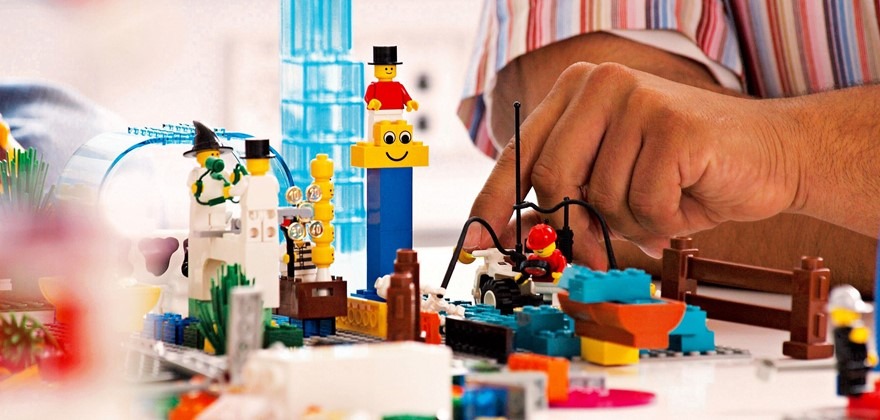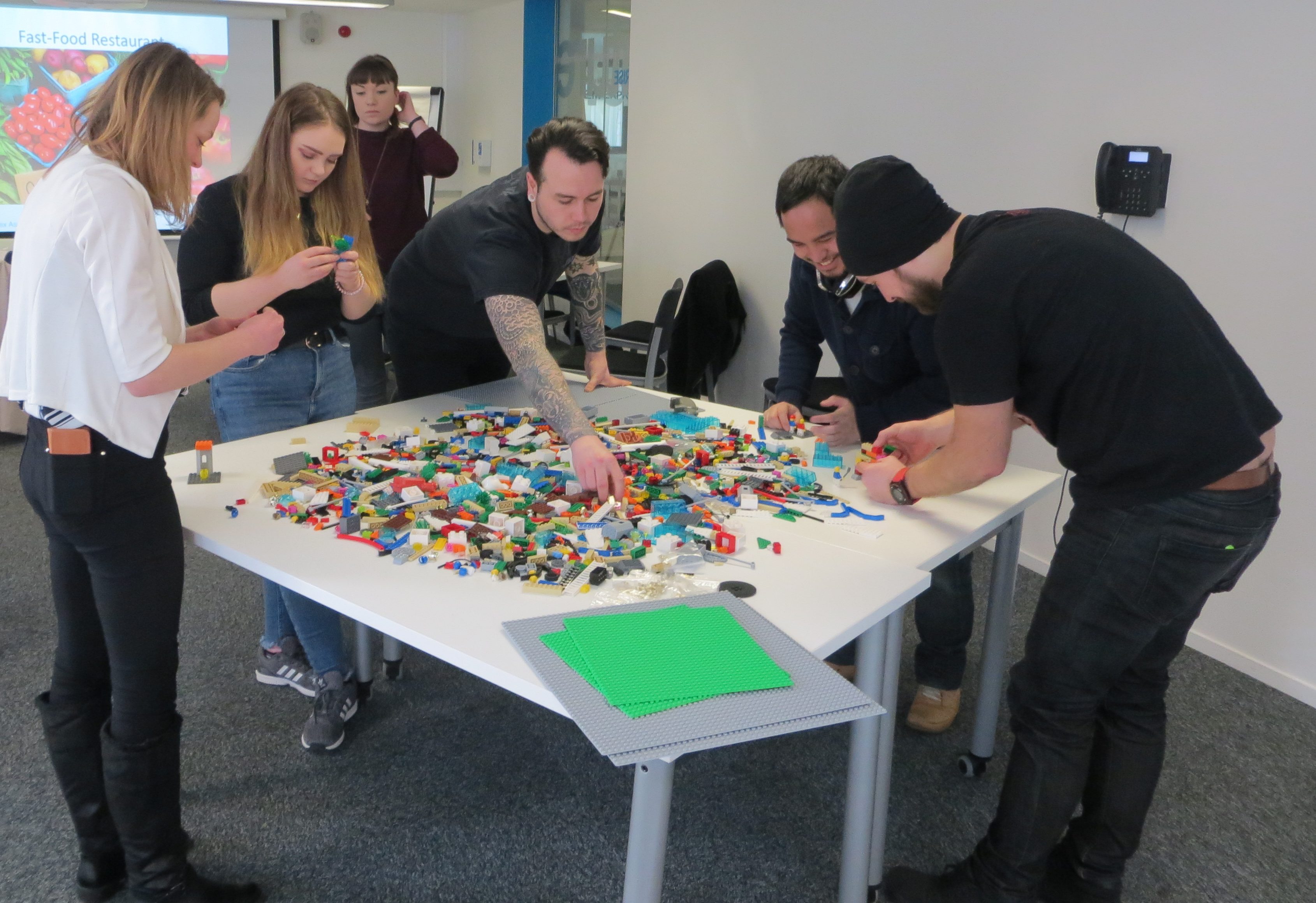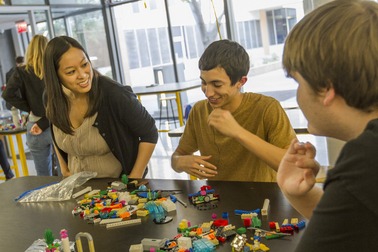Check out this blog post by Rory O’Connor. Rory is a trained LSP facilitator and now an entrepreneur running a start up in Ireland. I ran a workshop with his team where we used LEGO SERIOUS PLAY as the method to explore and develop their business model. We used the canvas developed by Osterwalder, Rory will be integrating the results into the LEAN Canvas developed by Ash Maurrya.
This is Rory’s first post on the session on his website
Using LEGO for Lean Startup!
If you follow the lean startup philosophy you will understand that words can mean a lot. What I mean is that when you try to capture the essence of the assumptions behind your business model on a single page with something like the strategy canvas, every word you use can be very important. Each word actually makes a difference and finding the right few words to capture all that insight you and your team have in your heads so that it will fit within the physical boundaries of the canvas segments can be quite difficult.
In theory forcing us to make it concise is good, it means we should really pick the right words, be careful with our language and make sure that the few words scrawled on Post-it notes in each of the canvas segments hold the same meaning for each member of the team. Of course its so important because if you are using a lean startup approach your team members will use these words on a daily basis to design the experiments to test the key assumptions in the business model.
The funny thing about language and words in particular is that most words have many meanings and applications. The meaning of a particular word or words can differ depending simply on location, with for example a public school in the UK meaning a fee paying private school and apparently in the US a public school is a state school which has no fees. Take as another example the word left which could mean “left behind” or “left hand”. And of course all you have to do is pick up two different dictionaries and look up a common word and you will often find subtle variations in meaning. If you ask any group what a particular term like profit means and get them to write down their meaning and take a look, you might be surprised at the variations you will get in the answers.
At Scurri.com we have been using a version of the strategy canvas, Ash Maurya’s lean canvas to document our business model and prioritise the experiments necessary to prove or disprove our key assumptions. The process itself is very powerful and it has already proved itself as an improvement on our previous processes. However one of the concerns I have is that I don’t think as a team we always have a fully shared understanding of the meaning of the words we write down. More importantly I don’t think we always really visualise and are fully aligned in our understanding of how all the different elements in the business model really fit together.
Individually I know we all had a sense deep in our mind of how the elements of the business model came together but I believe that normal discussions or workshops on their own regarding these key elements of the canvas did not allow us to go deep enough to get a real alignment of understanding amongst the team. I felt that each member of the team tended in their own mind to visualise the output of the words slightly differently to the next. Of course everyone on the team is unique and they view the world through different lenses, and that gives the team great strength but if we are not closely aligned in terms of understanding and meaning about the business model this can be a problem. What we are most concerned about is if you are not aligned you cant really act as a team and then the process of our testing assumptions becomes more difficult. Without alignment of understanding the team can be working against each other unknowingly.
For instance if you take a concept like the value proposition and google it, the amount of variation on the definition of this concept is startling. On our team (as with most teams) we have a variety of members who have attended different schools, have different backgrounds and different experiences. So when we record our output from a session into the value proposition segment of the canvas, we record the collective output using the words the person that happens to have the marker writes down. The recorder obviously will be somewhat influenced by their own training, background and experience in the interpretation and selection of the words they are going to use. So when the next team member reads the words it is possible they have a slightly different interpretation in their mind and thus a misalignment starts to occur. Up to this point within our organisation we have not spent too much time thinking about this and in the drive to move fast and iterate quickly when we rework an element on the canvas we have simply recorded the words that the person with the pen feels captures the meaning best, put them up on the canvas and moved on.
In hindsight there is a chance of something getting lost in translation and I think the something can be the detail of the knowledge, insight and learning that the team has built up over the previous days, weeks or months that a word or two on a post-it just doesn’t capture. As Eric Reis describes in his book the Lean Startup, sometime you just have to slow down to allow you to speed up again and in our case I think we came to that point with our Lean Canvas. Even though we had words up on the canvas we just felt the team needed to get more alignment on the shared understanding on each of the elements of the business model we were trying to test. So in true lean fashion we conducted an experiment.
The experiment we undertook to try and overcome these issues was to use LEGO bricks to build a three dimensional representation of our business model. This solution may sound a bit radical but there was a method to our madness. To be fair we didn’t just take a few bricks and start building without purpose, we used a scientifically proven concept which I had a good deal of previous experience of called LEGO® SERIOUS PLAY®. We used this powerful methodology to help the entire team to gain a really strong shared understanding of how each of the elements of the business model fit together. A new experimental workshop format was developed specifically for the purpose that combined the conceptual framework of the business canvas and using the LEGO SERIOUS PLAY process as a powerful method or language to accelerate the sharing insights and understanding.
The process entailed getting the team to use LEGO bricks to build metaphorical models to capture the meaning, knowledge and insights locked inside their heads and represent the key elements of the Business Model. The team then shared stories they made about the three dimensional LEGO objects bringing to life a three dimensional landscape that represented the business model and environment our Lean Startup is operating in.
The output from the workshop was amazing and powerful, the team could actually see what their colleagues meant as they described the elements of the canvas. Issues we were struggling to identify and understand dramatically revealed themselves during the process and we quickly got alignment on what we needed to prioritise and validate immediately in our Lean Startup. A secondary benefit of the process is it also gives participants who normally may not say as much in traditional workshops or sessions an equal voice and their feeling of inclusion in the output gives them a greater sense of inclusion and buy in to the output of the workshop.
Lessons Learned:
- The actual words you use to describe a concept, idea or solution can be important
- Our language can be interpreted in subtly different ways
- The Lean Canvas requires you to capture big ideas with a few words
- Gaining alignment on understanding is harder than it seems
- Lego Serious Play is a tool that can gain alignment, build a shared insight and focus the team on what needs to be done









 Become a LEGO Serious Play facilitator - check one of the upcoming training events!
Become a LEGO Serious Play facilitator - check one of the upcoming training events!
I have used the Lego Serious Play and Business Model Canvass combined in a few strategy sessions and it is very powerful. It can become complex when you have different business models per department (as I had with one of my clients) but they walked away with a better understanding of what each department is doing and how to better integrate their offerings and go-to-market value propositions.
The final models did not consist of 9 separate structures as per the business mode canvass as Lego allows one to integrate while building. But what happens is that the final model is very comprehensive and well thought through and constructed.
It appeals especially to people who are senior in organisations as this gives the Play a foundation with which they can relate and it makes a proposal more attractive and ‘serious”